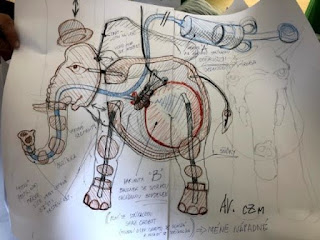Adding New Animations to an Old Craft: Transitions Online looks at Czech Marionettes
"A crowd of marionettes, ranging from monkeys playing the saxophone to dragon-headed men, dangles on the wall of a puppet workshop. This place might seem like any other overpriced marionette shop in Prague’s Old Town Square, if it weren’t for the expensive, bright-orange, 3D printer in the front of the shop.
Marionettes have also started to be incorporated into other industries and traditions besides entertainment, such as psychological therapy. Even before World War II, marionettes had been established as a successful counseling tool to help children cope with illness or separation from their parents, according to psychologists Lauretta Bender and Adolf Woltmann.
In a study published in 1936, Bender and Woltmann found that hospitalized children’s aversion to treatment subsided if they had previously seen a puppet undergoing the same treatment. They also discovered that shy children could better identify with puppets than with adults, and could use puppets to build self-esteem, overcome emotional isolation, and better express their feelings to counselors.
Rather than the traditional reliance on string operation, the next-generation marionette industry on display here has adopted some genuinely cutting-edge techniques, through the use of technology like the 3D printer. This shop’s elephant, for example, can spout water from its trunk."
 |
| A sketch of an elephant marionette, which will be professionally used by a puppet theater company. |
Marionettes have also started to be incorporated into other industries and traditions besides entertainment, such as psychological therapy. Even before World War II, marionettes had been established as a successful counseling tool to help children cope with illness or separation from their parents, according to psychologists Lauretta Bender and Adolf Woltmann.
In a study published in 1936, Bender and Woltmann found that hospitalized children’s aversion to treatment subsided if they had previously seen a puppet undergoing the same treatment. They also discovered that shy children could better identify with puppets than with adults, and could use puppets to build self-esteem, overcome emotional isolation, and better express their feelings to counselors.



Comments
Post a Comment